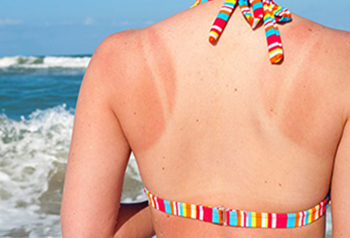
Sunburns by Janell Pierce
 Summer is here and there’s no avoiding the sun or any kind of exposure to ultraviolet light. Overexposure of either one can cause skin irritation or damage. This could lead to sunburns which are common here in Southern California throughout the summer. Exposure to both types of radiation can increase the risk of several conditions such as:
Summer is here and there’s no avoiding the sun or any kind of exposure to ultraviolet light. Overexposure of either one can cause skin irritation or damage. This could lead to sunburns which are common here in Southern California throughout the summer. Exposure to both types of radiation can increase the risk of several conditions such as:
- Wrinkles
- Dark Spots
- Skin Cancer
Sunburns are caused by ultraviolet radiation, either from the sun or from artificial sources, such as tanning. This damage is mainly the formation of a thymine dimer. When the body recognizes this damage, it trigger s several defense mechanisms, including DNA repair to reverse the damage, peeling to remove irreparably damaged skin cells, and increased melanin production to prevent future damage. Melanin acts as a skin protector and automatically absorbs ultraviolet wavelength light. Melanin inhibits both the direct alteration of DNA and indirect DNA damage, preventing ultraviolet photons from disrupting chemical bonds. Skin type usually determines the ease of a sunburn. People with lighter skin tones have a greater risk of sunburn. Age can also affect how skin reacts to sun. Children younger than six and adults older than sixty are more sensitive to sunlight.
s several defense mechanisms, including DNA repair to reverse the damage, peeling to remove irreparably damaged skin cells, and increased melanin production to prevent future damage. Melanin acts as a skin protector and automatically absorbs ultraviolet wavelength light. Melanin inhibits both the direct alteration of DNA and indirect DNA damage, preventing ultraviolet photons from disrupting chemical bonds. Skin type usually determines the ease of a sunburn. People with lighter skin tones have a greater risk of sunburn. Age can also affect how skin reacts to sun. Children younger than six and adults older than sixty are more sensitive to sunlight.
The most effective way to prevent sunburn is to reduce the amount of ultraviolet radiation reaching the skin. Some recommendations include:
- Seeking shade
- Avoiding peak exposure (between the hours of 10 am – 4pm)
- Wear protective clothing / sunglasses and hats
- Use sunscreen
Sunscreens or sunblocks are the most common preventatives that block ultraviolet light. They have a SPF rating which indicates the sunblock’s ability to suppress sunburn. The higher the SPF rating, the lower the amount of direct skin damage. Broad-spectrum sunscreens contain filters that protect against ultraviolet radiation. The best sunscreen protection is achieved by applying 15 to 30 minutes before exposure, followed by one reapplication 15 to 30 minutes after exposure begins. Further reapplication is necessary only after activities such as:
- Swimming
- Sweating
- Rubbing
This can vary based on the kind of sunscreen being used.
The information provided is for general interest only and should not be misconstrued as a diagnosis, prognosis or treatment recommendation. This information does not in any way constitute the practice of medicine, or any other health care profession. Readers are directed to consult their health care provider regarding their specific health situation. Marque Medical is not liable for any action taken by a reader based upon this information.
